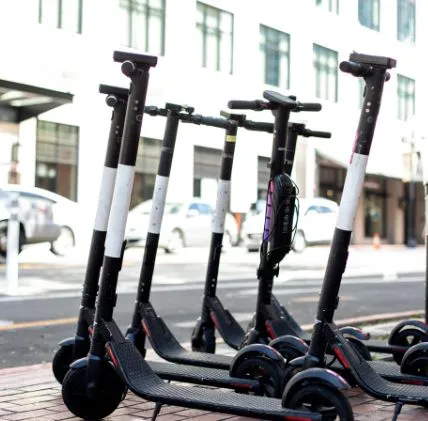Electric scooters can have different types of brakes, including disc brakes, drum brakes, and regenerative brakes. The type of brake used depends on the scooter model and manufacturer.

Contents
- 1 Hydraulic Brakes
- 2 Disc Brakes
- 3 Drum Brakes
- 4 Frequently Asked Questions
- 4.1 What Types Of Brakes Are Found In Electric Scooters?
- 4.2 How Do Mechanical Brakes Work In Electric Scooters?
- 4.3 What Are The Advantages Of Mechanical Brakes In Electric Scooters?
- 4.4 What Are Regenerative Brakes In Electric Scooters?
- 4.5 What Are The Benefits Of Regenerative Brakes In Electric Scooters?
- 5 Final Thoughts
Hydraulic Brakes
Hydraulic brakes are a popular type of electric scooter brakes that provide efficient stopping power. With their hydraulic mechanism, they offer superior control and responsiveness, ensuring a safe and smooth riding experience.
Working Mechanism Of Hydraulic Brakes
- Hydraulic brakes are a type of braking system commonly found in electric scooters. They work by using fluid pressure to transmit force from the rider’s hand on the brake lever to the brakes themselves.
- The key components of hydraulic brakes include a master cylinder, brake lines, calipers, and brake pads.
- When the rider squeezes the brake lever, it activates the master cylinder, which pushes hydraulic fluid through the brake lines.
- The fluid pressure forces the calipers to close, causing the brake pads to squeeze against the brake disc or drum.
- This friction between the brake pads and the disc or drum slows down the rotation of the electric scooter’s wheels, ultimately stopping the scooter.
Advantages Of Hydraulic Brakes
- Responsive and powerful braking: Hydraulic brakes offer excellent stopping power, providing riders with strong and reliable braking performance.
- Minimal effort required: Compared to other types of brakes, hydraulic brakes require less force to operate. This means riders can easily control and modulate their speed with just a light squeeze of the brake lever.
- Self-adjusting: Hydraulic brakes have a self-adjusting mechanism that ensures consistent braking performance over time. As the brake pads wear down, the system automatically compensates to maintain optimal braking efficiency.
- Low maintenance: Hydraulic brakes are generally low maintenance. They are less prone to damage from dirt and debris, and the sealed system reduces the need for frequent adjustments or replacements.
Disadvantages Of Hydraulic Brakes
- Complexity and cost: Hydraulic brakes are more complex and expensive compared to mechanical brakes. The system requires additional components and regular fluid maintenance, resulting in higher upfront and maintenance costs.
- Bleeding and air bubbles: Occasionally, hydraulic brakes may develop air bubbles in the system, affecting the overall braking performance. Bleeding the brakes to remove air bubbles is necessary but can be a time-consuming process.
- Expertise required for repair: Repairing hydraulic brakes may require specialized knowledge and tools. While regular maintenance can be performed by an experienced rider, major repairs are best left to professionals to ensure proper functioning of the braking system.
Overall, hydraulic brakes provide strong stopping power and excellent control, making them a popular choice for electric scooter riders. However, their higher cost and complexity may deter some riders who prefer simpler and more affordable braking systems.
Disc Brakes
Disc brakes are an essential type of electric scooter brakes. They offer reliable stopping power and durability, ensuring safe and efficient rides.
Working Mechanism Of Disc Brakes
- Disc brakes are a popular braking system used in electric scooters, known for their efficient and reliable performance.
- The working mechanism of disc brakes involves a rotor, caliper, brake pads, and hydraulic system.
- When the rider applies the brake lever, hydraulic fluid is forced into the caliper, which in turn applies pressure on the brake pads.
- The brake pads come in contact with the rotor, causing friction that slows down and ultimately stops the electric scooter.
- The disc brake system provides excellent stopping power, allowing riders to have better control over their scooter’s speed.
Advantages Of Disc Brakes
- Disc brakes have several advantages over other types of brakes, making them a popular choice for electric scooters:
- Enhanced stopping power: Disc brakes offer superior stopping power, allowing riders to quickly and effectively bring their electric scooters to a halt, ensuring enhanced safety.
- Heat dissipation: The design of disc brakes allows for efficient heat dissipation, preventing brake fade that can occur during prolonged or heavy braking.
- Low maintenance: With fewer moving parts, disc brakes are relatively low maintenance, requiring less frequent adjustments and replacements compared to other brake systems.
- Consistent performance: Disc brakes provide consistent braking performance regardless of weather conditions, making them reliable in both dry and wet conditions.
- Compatibility with different wheel sizes: Disc brakes can be easily adapted to different wheel sizes, providing versatility for electric scooters of various sizes and types.
Disadvantages Of Disc Brakes
- Despite their many advantages, disc brakes do have some drawbacks to consider:
- Cost: Disc brakes tend to be more expensive than other types of brakes due to their complex design and the use of hydraulic systems. This can increase the overall cost of the electric scooter.
- Weight: Disc brakes add additional weight to the electric scooter, which may affect its overall maneuverability and agility.
- Maintenance complexity: While disc brakes are generally low maintenance, repairs or replacements may require more technical expertise compared to other brake systems.
- Noise: Disc brakes can sometimes generate noise during braking, which may be bothersome to some riders.
- Wear on the rotor: Continuous braking can lead to wear and tear on the rotor, requiring periodic replacement to maintain optimal braking performance.
Disc brakes are a popular choice for electric scooters due to their enhanced stopping power, heat dissipation, and low maintenance. However, factors such as cost, weight, and maintenance complexity should also be considered when choosing the braking system for an electric scooter.
Drum Brakes
Drum brakes are a common type of electric scooter brakes. They are reliable and effective, providing smooth stopping power. Their design includes brake shoes that press against the inner surface of the drum to slow down or stop the scooter.
Drum brakes are one of the types of electric scooter brakes that have been widely used in various vehicles for decades. They work on a simple yet reliable mechanism that effectively slows down and stops the scooter when needed. While drum brakes may not be as commonly used in modern electric scooters, they still have some advantages that make them worth considering.
However, like any other braking system, drum brakes also have their own set of disadvantages. In this section, we will explore the working mechanism of drum brakes, along with their advantages and disadvantages.
Working Mechanism Of Drum Brakes:
- Two brake shoes: Drum brakes consist of two brake shoes that are lined with friction material. These brake shoes are located inside a drum, which is attached to the rotating wheel of the scooter.
- Hydraulic or mechanical force: When the rider applies the brake, hydraulic or mechanical force is used to press the brake shoes against the inner surface of the drum.
- Friction slows down the wheel: As the brake shoes press against the drum, friction is generated, which slows down the rotation of the wheel. This frictional force eventually brings the scooter to a stop.
Advantages Of Drum Brakes:
- Cost-effective: Drum brakes are generally less expensive to manufacture and maintain compared to other types of brakes, making them an economical option.
- Self-adjusting mechanism: Drum brakes come with a self-adjusting mechanism that automatically compensates for brake shoe wear. This reduces the need for frequent adjustments and ensures consistent braking performance.
- Less affected by environmental factors: Drum brakes are less prone to getting affected by water, mud, or other external elements. Their enclosed design provides better protection, allowing them to work reliably in various conditions.
Disadvantages Of Drum Brakes:
- Heat buildup: Due to their enclosed design, drum brakes are more prone to heat buildup during prolonged or intensive use. This can lead to reduced braking efficiency and potential brake fade.
- Lower braking power: Compared to disc brakes, drum brakes generally offer lower braking power. This means they may require a longer stopping distance, especially in emergency situations.
- More weight: Drum brakes are bulkier and heavier than disc brakes, which can add unnecessary weight to the electric scooter. This extra weight may affect the scooter’s overall performance and maneuverability.
Drum brakes provide a cost-effective braking solution with a self-adjusting mechanism and resistance to external factors. However, they have limitations such as heat buildup, lower braking power, and additional weight. When choosing electric scooter brakes, it is important to consider your specific requirements and riding conditions to determine if drum brakes are the right choice for you.
Frequently Asked Questions
What Types Of Brakes Are Found In Electric Scooters?
Electric scooters commonly have two types of brakes: mechanical brakes and regenerative brakes.
How Do Mechanical Brakes Work In Electric Scooters?
Mechanical brakes in electric scooters operate similar to traditional bicycle brakes by applying friction to slow down or stop the scooter.
What Are The Advantages Of Mechanical Brakes In Electric Scooters?
Mechanical brakes provide reliable stopping power, are easy to maintain, and are not affected by battery levels or system failures.
What Are Regenerative Brakes In Electric Scooters?
Regenerative brakes in electric scooters use the motor’s resistance to slow down the scooter while simultaneously recharging the battery.
What Are The Benefits Of Regenerative Brakes In Electric Scooters?
Regenerative brakes improve overall energy efficiency, increase battery life, and reduce brake wear and tear.
Final Thoughts
To sum up, understanding the different types of electric scooter brakes is crucial for both safety and performance. The three main types, including drum brakes, disc brakes, and regenerative brakes, each have their own advantages and disadvantages. Drum brakes excel in their durability and low maintenance requirements, making them a popular choice for electric scooters.
On the other hand, disc brakes provide superior stopping power and heat dissipation, making them well-suited for more demanding riding conditions. Lastly, regenerative brakes offer the added benefit of energy regeneration, extending the battery life of the scooter. Ultimately, the choice of electric scooter brake depends on personal preference, riding style, and intended use.
Whether you prioritize durability, power, or energy efficiency, it’s important to choose a brake system that suits your needs and enhances your overall electric scooter experience. Safely enjoy your electric scooter rides by understanding and utilizing the right type of brakes for your adventure.


